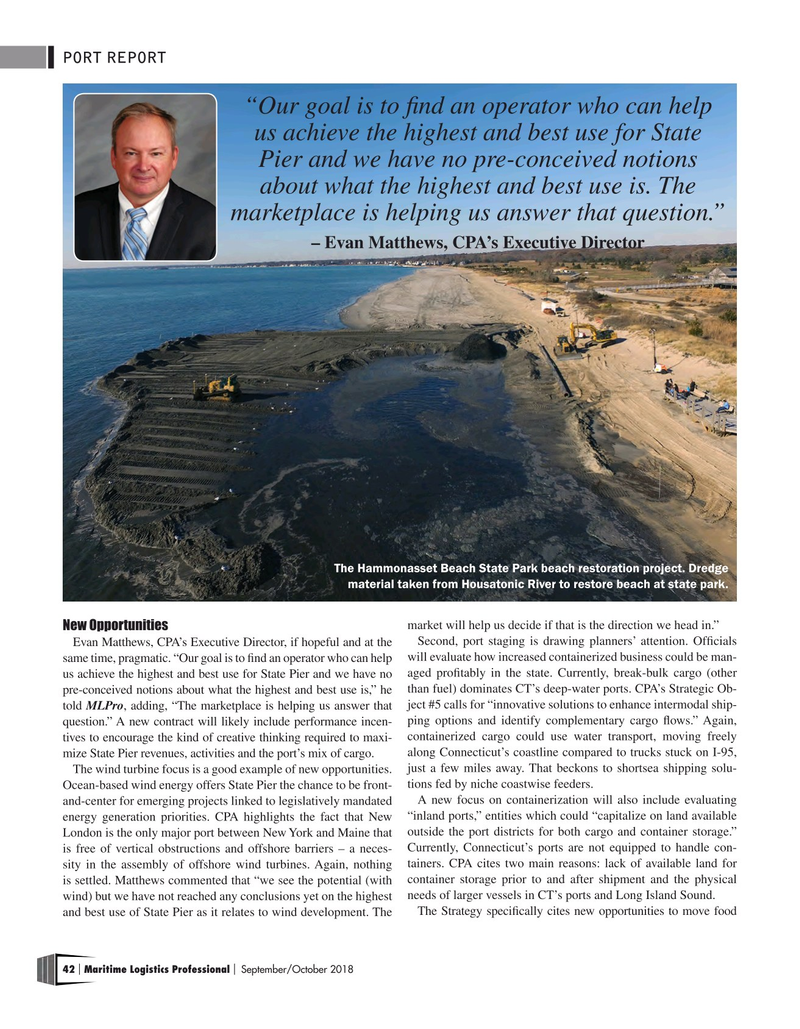
Page 42: of Maritime Logistics Professional Magazine (Sep/Oct 2018)
Liner Shipping & Logistics
Read this page in Pdf, Flash or Html5 edition of Sep/Oct 2018 Maritime Logistics Professional Magazine
PORT REPORT “Our goal is to fnd an operator who can help us achieve the highest and best use for State
Pier and we have no pre-conceived notions about what the highest and best use is. The marketplace is helping us answer that question.” – Evan Matthews, CPA’s Executive Director
The Hammonasset Beach State Park beach restoration project. Dredge material taken from Housatonic River to restore beach at state park.
market will help us decide if that is the direction we head in.”
New Opportunities
Evan Matthews, CPA’s Executive Director, if hopeful and at the Second, port staging is drawing planners’ attention. Offcials same time, pragmatic. “Our goal is to fnd an operator who can help will evaluate how increased containerized business could be man- us achieve the highest and best use for State Pier and we have no aged proftably in the state. Currently, break-bulk cargo (other pre-conceived notions about what the highest and best use is,” he than fuel) dominates CT’s deep-water ports. CPA’s Strategic Ob- told MLPro, adding, “The marketplace is helping us answer that ject #5 calls for “innovative solutions to enhance intermodal ship- question.” A new contract will likely include performance incen- ping options and identify complementary cargo fows.” Again, tives to encourage the kind of creative thinking required to maxi- containerized cargo could use water transport, moving freely mize State Pier revenues, activities and the port’s mix of cargo. along Connecticut’s coastline compared to trucks stuck on I-95,
The wind turbine focus is a good example of new opportunities. just a few miles away. That beckons to shortsea shipping solu-
Ocean-based wind energy offers State Pier the chance to be front- tions fed by niche coastwise feeders.
and-center for emerging projects linked to legislatively mandated A new focus on containerization will also include evaluating energy generation priorities. CPA highlights the fact that New “inland ports,” entities which could “capitalize on land available
London is the only major port between New York and Maine that outside the port districts for both cargo and container storage.” is free of vertical obstructions and offshore barriers – a neces- Currently, Connecticut’s ports are not equipped to handle con- sity in the assembly of offshore wind turbines. Again, nothing tainers. CPA cites two main reasons: lack of available land for is settled. Matthews commented that “we see the potential (with container storage prior to and after shipment and the physical wind) but we have not reached any conclusions yet on the highest needs of larger vessels in CT’s ports and Long Island Sound.
and best use of State Pier as it relates to wind development. The The Strategy specifcally cites new opportunities to move food 42 Maritime Logistics Professional September/October 2018 | |

 41
41

 43
43
